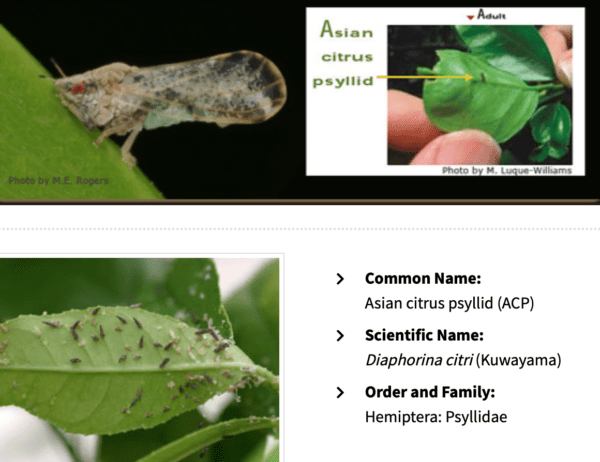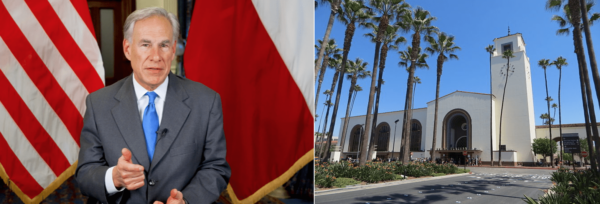The Board of Supervisors Tuesday approved Riverside County Agricultural Commissioner Ruben Arroyo’s request for his office to remain under contract with the state to enforce regulations aimed at combating citrus greening disease.
In a 5-0 vote without comment, the board signed off on the $751,594 agreement with the California Department of Food & Agriculture to take all necessary steps to contain and prevent spread of Asian citrus psyllid infestations, which cause greening disease, also known as Huanglonbing, or HLB.
The contract will expire on Sept. 30, 2024.
The county’s commercial citrus crops, spread across roughly 20,000 acres, are valued around $200 million. For the last six years, the board has maintained a local emergency declaration connected to greening disease.
Last year, over 80 residential citrus trees countywide were plagued with HLB.
In July 2017, a grapefruit tree and two other trees in the area of Chicago and Marlborough avenues on the east end of Riverside became infested with psyllids, prompting the state to place a quarantine over a 94-square-mile area encompassing both Riverside and San Bernardino counties.
Under the still-active order, only citrus products that are “commercially cleaned and packed” are permitted to be shipped out of the quarantine zone.
No citrus nursery stock can be moved outside the area under quarantine, and no residentially grown citrus fruit can be moved. However, growers are permitted to consume and share with people within the quarantined locations.
A map of the impacted area, along with the boundaries of similar quarantines in Los Angeles and Orange counties, can be found at cdfa.ca.gov/citrus/pests_diseases/hlb/regulation.html.
The board first declared a local state of emergency in August 2017 because of the potential spread of greening disease.
The city of Riverside’s foundational citrus-bearing tree, known as the “parent navel orange tree,” located at the intersection of Arlington and Magnolia avenues, received protective netting and treatment in April 2019 to prevent an Asian citrus psyllid infestation. The tree is listed as a California Historic Landmark and has been preserved since 1873.

Psyllids host virulent bacteria that cause HLB, which destroys plants’ vascular systems, rendering fruits misshapen and unmarketable. The disease typically kills infected trees within a few years.
The finger-tip size, moth-like insects arrived in the U.S. in the 1990s. The disease rampaged throughout Florida in 2005 and has since inflicted over $3 billion damage to crops in the Sunshine State, according to a study published by the University of Florida.
Psyllids originate in tropical and subtropical regions. They first appeared in California in 2008 and have been trapped throughout the Inland Empire.
Budget ‘cleanup’
Also on Tuesday, the Board of Supervisors approved budget adjustments totaling $22.2 million to cover expenses borne by Riverside County agencies that spilled over from the previous fiscal year.
In a 5-0 vote without comment, the board signed off on the obligations, as requested by the Executive Office.
In June, the board approved an $8.61 billion budget for county government in the current fiscal year. However, some costs from 2022-23 were not yet factored into appropriations, and a review of the previous year’s outlays indicated there were over-hanging expenditures that required attention.
“The unresolved year-end adjustments are submitted by departments for board approval in order to ensure a balanced budget within the budgetary unit before the fiscal year is closed,” according to an Executive Office statement.
Most of the spill-over IOUs will be pared down by accounts other than the General Fund, though roughly $2.4 million will have to be extracted from it, officials said.
The “Year-End Cleanup Budget Report” showed a required reduction in the county’s principal contingency account to meet some of the expenses, drawing it down from $20 million to $6.24 million.
The projection at the beginning of 2023-24 was for reserve funds to reach $555 million by the end of the fiscal year, compared to an estimated $537 million reserve pool at the close of the last one in June. The Executive Office told City News Service the latest round of expenses will not impact that projection.
The budget remains structurally balanced, officials said.
County CEO Jeff Van Wagenen said in June the current budget “creates the opportunity to enhance the efforts of our departments providing vital programs for our constituents countywide.”
The 2023-24 budget is roughly 15% larger than 2022-23’s, which was about $7.45 billion. Close to half of the appropriations are comprised of state and federal “pass-through” funds, over which the board has little to no control.







